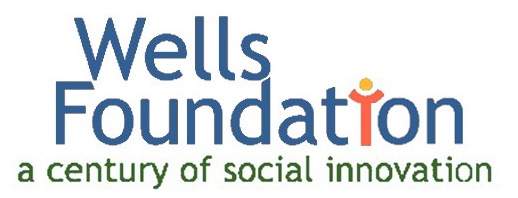History
It All Began with a Sewing Machine
The Wells Foundation traces its roots back to the 1880s, when Annie Wells, the wife of St. Mark’s Rector Thomas Bucklin Wells, allowed a German immigrant neighbor to use her sewing machine and gave her lessons in “modern” sewing. Soon, more nearby immigrant women asked for lessons. Annie was soon overwhelmed, and asked for help from other women in the parish.
The women petitioned the St. Mark’s Vestry to purchase three sewing machines so they could continue their endeavors. There was a substantial debate on the subject with some Vestry members believing that the women should raise all of the money themselves, since this was “women’s work”.

Rev. Thomas Bucklin Wells,
Rector of St. Mark’s Cathedral
Give Someone a Fish vs. Teach Someone to Fish

Photo from 1926 showing women,
nurses, children & visitors at Wells
To assist with childcare, a kindergarten and nursery school were established. Classes were started for school-age children. English and civics classes were taught in the evening.
The Vestry agreed to purchase ONE sewing machine, leaving the women to raise funds for the other two. The women raised enough money to buy EIGHT more machines.

Boys building a model city
The demand for sewing education continued to grow, as women with sewing skills could often find work when their husbands could not. Before long, classes were offered in sewing, serving, childcare and typing.
From a Sewing Machine to a Full-Service Facility

Photo of the original Wells Settlement House
The Wells Memorial Settlement House was established in 1908 to accommodate these services. At Wells Memorial, volunteers and social workers provided medical, social and educational services to the surrounding community. Over the years, the settlement house provided daycare to working mothers, as well.
Neighborhood people could send their children to kindergarten or day nursery at the house and find books, search for work and obtain treatment for illness. Immigrants and Minneapolis residents of varying religious affiliations could also use the house for their own meetings. For instance, in 1920 Jewish athletes organized a sporting club there. Finnish and other immigrants also connected with each other at the facility.
In addition to the time, effort and skill of countless volunteers the operation was blessed to be the beneficiary of monetary gifts from many community and business leaders who were associated — or at least familiar — with St. Mark’s and the Wells programs.

Volunteer with a young girl and her doll
From a Facility to an Endowment
In the mid-1920s Wells became a non-profit tax-exempt entity. When the settlement house and other properties were sold, Wells put the funds into an endowment for the future needs of the community, and this endowment has been augmented with generous gifts over the years. Wells Memorial House was sold in 1948, and the foundation took a new direction as described in the book St. Mark’s: A Parish Church and a Cathedral:
In September of that year, Richard J. Parvis of Kansas City was placed in charge of directing a radically new method of social service work, which calls for cooperative use of homes, schools, churches and community facilities of various kinds. Wells no longer aims to supply directly all the needs of the people it serves but rather to help them to help themselves. It now styles itself “a neighborhood partner in social and recreational activities.” It is believed that this conforms with the original intent of Wells Memorial’s founders.
Modern Times
The Wells Foundation has always been interested in diagnosing and treating the causes of the poverty and misery in the community. Check out:
- Our slideshow of historic photos describing Wells programs over the years.
- The story of our early donors.
- The groups we have funded during from 2018-2022.
Contact Us
Contact us via email by selecting the individual below
Mailing Address
The Wells Foundation
c/o St. Mark’s Episcopal Cathedral
519 Oak Grove
Minneapolis, MN 55403
